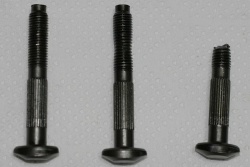By Jim Kerr; Photo courtesy BigInJapan.co
The way cars are put together has changed. Adhesives, plastic clips and even Velcro have replaced most of the screws and trim nails used to hold panels together in the past. Bolts, however, are still used for assembling most of the mechanical components, but even bolts have changed too. Many engines, transmissions and even suspensions now use torque-to-yield bolts to connect major assemblies.
Torque-to-yield bolts are exactly what they sound like. They stretch to the yield point as they are tightened. These bolts are commonly used where exact clamping loads are required on parts. You may find them used to hold cylinder heads, connecting rods, crankshaft main bearing caps, flywheels, front engine dampers, steering knuckles and transmission pumps. When a shop manual indicates that a bolt is to be discarded and new ones used, they are almost always torque-to-yield bolts.
Buying new bolts every time one is removed seems expensive and a waste of time. After all, the old ones still look good, but looks can be deceiving. Re-using the old bolts can cause expensive failure. During the tightening process, the bolts have been pulled to their elastic limit. The bolts actually stretch. Only new bolts can provide the even clamping force needed on today’s engines.
The more a bolt is tightened, the harder it is to obtain accurate clamping load with the bolt. Friction and stiction are the enemies. Friction occurs as the bolt is being tightened. The threads on a bolt are like a ramp. As the bolt is turned, the ramp must slide against another thread or ramp in the bolt hole. The tighter the bolt, the harder it is to push or move up the thread’s ramp. The tightening force can be compared to a person pushing a box up a ramp. If the weight of the box is increased, it takes a lot more force to move the box.
Stiction is stationary friction. Starting the bolt turning takes more force than keeping it turning. The tighter the bolt, the more stiction can affect torque readings. Lubrication helps the threads slide easier but one lubricant differs from another in their lubricating qualities. Manufacturers will specify what type of lubricant, if any, to use on a bolt when torquing it. Use a different lubricant and the part may not be tightened enough or it could be clamped too tight.
Tightening torque-to-yield bolts is done in several stages using a combination of torque and turning angle. First, the bolts are tightened to a low torque specification so that even clamping load is placed on the parts being assembled. Often, the bolts are tightened again to a slightly higher torque as a second stage. This is still a low enough torque that friction and stiction on the bolt threads affect tightening torque very little. Then each bolt is turned a specified number of degrees usually in two or three steps. For example, each bolt might be turned 90 degrees, then another 90 degrees and the tightening completed by turning a final 70 degrees. The clamping force exerted by the bolts is accurate and even.
There are special tools available that measure the degrees a bolt or wrench is turned. Some tools are low cost protractors with a moveable pointer, while other tools use electronics to measure the turning angle and cost several hundred dollars. Both types of tools work well but the electronic ones make the job go faster.
Why do we need these torque-to-yield bolts now? We didn’t need them in the 1960s or ’70s! The simple answer is that materials are different. For example, aluminum cylinder heads expand at a different rate than cast iron blocks. As an engine warms up, bolted-together parts have to move against each other or slide on their gaskets. The elastic properties of the torque-to-yield bolts allow movement between parts yet maintain even clamping loads and sealing.
Engine parts are also lighter than they were a few decades ago. Heavy cast iron parts could withstand some variations in torque without failures. Thin wall castings and aluminum alloys used today require extremely accurate torque or warping and leaks occur.
Even the way engines are designed is changing because of the need for even clamping forces. For example, there are prototype engines where the bolts that hold the cylinder head on pass all the way through the engine block and thread into the bottom casting that holds the crankshaft. Imagine only a few bolts holding the complete engine together. That would certainly change the way we assemble and disassemble engines of the future.












